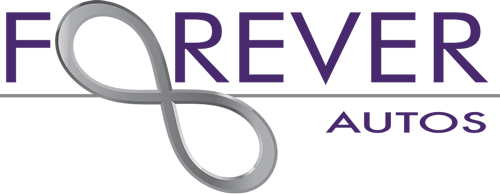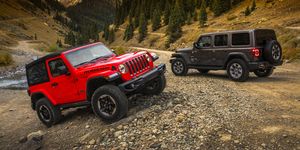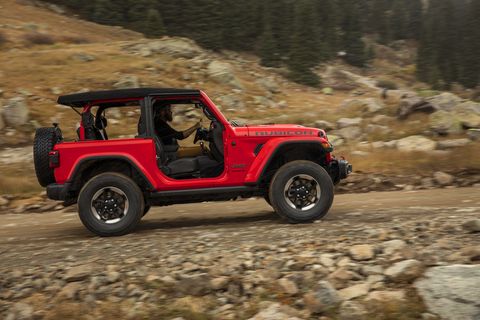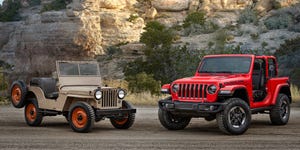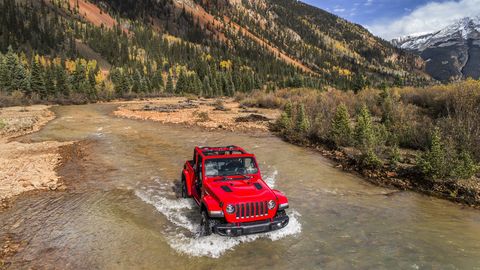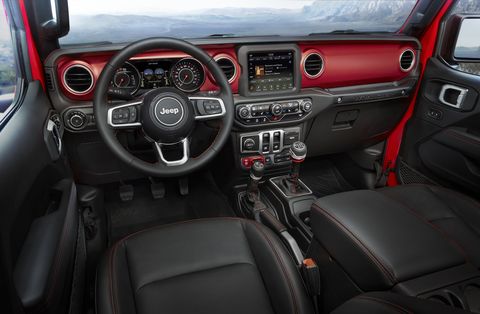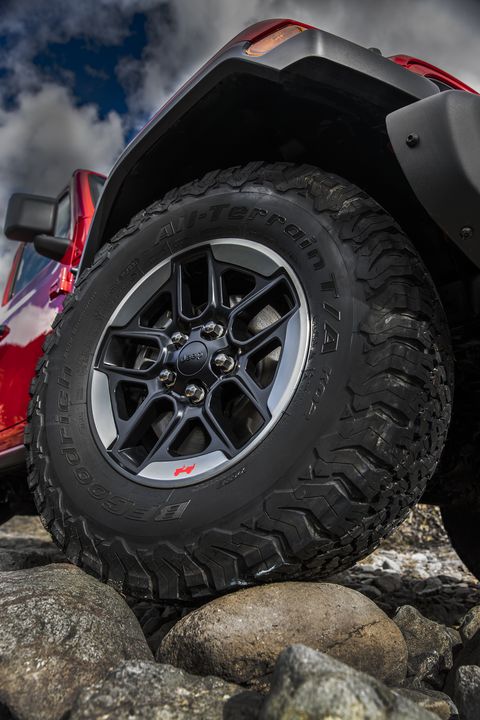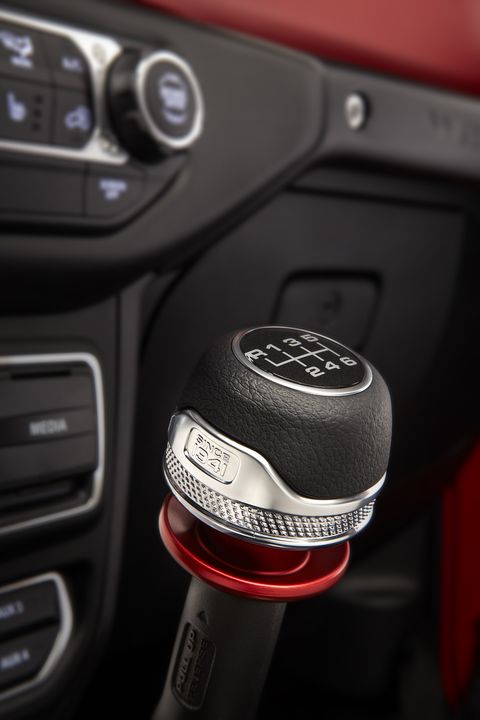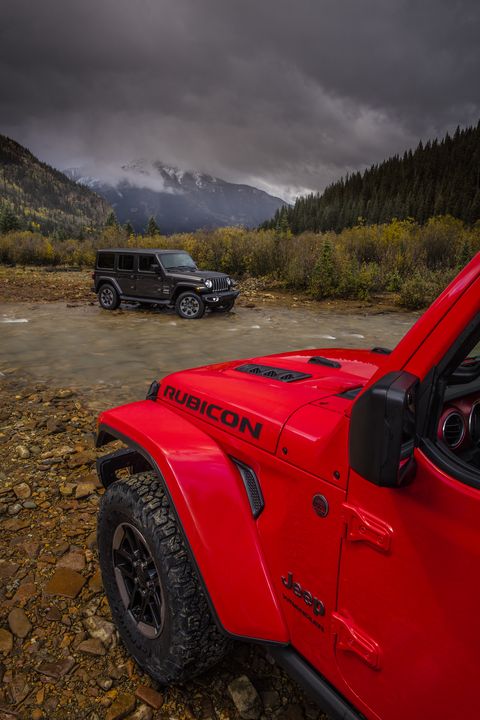“I was accosted in the hallway by an engineer,” Mark Allen tells me. “He’s like, 'we’ve gotta get rid of the folding windshield.'”
The head of Jeep design explains that, for manufacturing, the Wrangler’s traditional hinged windshield is a hassle, basically another door to paint, align and seal. Hardly anyone uses it.
But a flip-down windscreen let the United States Army ship the original Jeep to combat zones in wooden crates. When it comes to the Wrangler, the descendent of the truck that won World War II, Jeep never thinks too far outside that box.
So the all-new 2018 Jeep Wrangler has a folding windshield. It’s massively improved: Just four bolts to remove, compared to nearly 30 on the previous generation. You don't have to disassemble the front half of the roll-bar anymore—the new body-color cage finally has A-pillar bars, and a header bar keeps the rear-view mirror and visors in place. The tool comes in the console.
Why hang on to this throwback feature? “For shipping,” Allen says with a smile. “And sometimes there’s a guy in the back with a Howitzer.”
Optimized tradition is the whole story with the new Wrangler. You won't find any drastic departures from the original recipe here: The axles are still solid, the roof and doors still come off, the body still bolts to the frame. Everything that makes people exuberantly, irrationally love the Wrangler is still here. It's just been finessed in a way that won't jostle a die-hard's sensibilities.
There are tons of friendly new features. The pop-off doors are lighter, with a handy new lift point carved into the underside of the armrest. The hinges say T50, to remind you what size Torx bit disassembles them, and the pins are staggered lengths to make re-hanging the door easy. The canvas top, once a straitjacket of zippers, now slides together with tongue-and-groove fasteners. A spring-loaded mechanism makes flopping the roof open a one-person job, even on four-door models. There's even an optional power-folding roof, basically a hardtop with a giant sliding canvas sunroof and removable quarter windows, so you can finally open your Wrangler at a stoplight.
The styling is purposefully familiar. "My personal favorite thing is the CJ-5," Allen told me. The very first Jeep, the flat-fendered CJ-2A, was shaped by engineers to meet the military's constraints. The CJ-5, introduced in 1955, was the first time the design department's phone rang, Allen said.
You see the influences immediately. There's the trapezoidal grille, vertical at the bottom, kinked back at the top for improved aerodynamics. The headlights, larger, now cheat into the outer grille slots, a vintage Jeep styling feature incidentally invented when Willys crammed federally-mandated seven-inch lamps into the WWII truck's headlight buckets.
This new, JL-generation Wrangler is slightly larger than the outgoing JK model—the two-door is 2.8 inches longer overall, on a 1.4-inch-longer wheelbase; the four-door grows 3.8 and 2.4 inches, respectively. All models are 0.2 inches wider, sitting on a track widened by 2.5 inches. "You don't want to grow it too much," Allen told me. "The trails are all this size."
Parked next to a JK, you'd swear the JL is smaller. Scaling, the designers call it. A bigger grille and headlamps, narrower bumpers and fender flares, and a wider stance make the new Wrangler's added inches disappear. In a way, it makes the JK disappear, too—the JL is styled as if the previous Wrangler never existed, like time leapt straight from the beloved 1996-2006 TJ to 2018.
The interior is thankfully modernized. Luxuries that were once anathema in an open-top 4x4, like push-button start and a giant touchscreen, suddenly fit right in. It feels more spacious: The weird protruding hump of the current model's dashboard center-stack is gone, leaving a shallow, flat-topped instrument panel.
Every piece of glass has been enlarged. "I'm a heretic for lowering the beltline," Allen said. "The previous car was built in the generation where you couldn't get it high enough. It makes such bad sense for off-road. You're trying to constantly look out and maneuver." Engineers assure me that, despite all the new electronics and infotainment features, everything still functions after a roof-off rainstorm. As ever, there are drain plugs in the floor.
Jeep invited journalists to spend three days driving top-spec Rubicon models off-road in New Zealand. From the top of a precarious mountain trail, through a rain-slick rock crawl and across rushing streams up to our headlights, the new Jeep ate it all up.
The Rubicon now rides on 33-inch tires (largest ever fitted to a factory Jeep), with locking differentials front and rear, an electric-disconnect front sway bar, and a full suite of skid plates. The fender flares sit two inches higher on the body than Sport and Sahara models; the wheelwells have clearance for 35s.
Three drivetrains were available to us: The familiar 3.6-liter V6 with either a six-speed manual or a new eight-speed automatic, and an all-new 2.0-liter turbocharged four-cylinder, automatic only. Diesel and plug-in hybrid options come later.
With 285 horses and 260 lb-ft on tap, the V6 manual is peppy fun, save for the occasional clutch-frying off-road moment. The long-throw, narrow-gate shifter is now cable-operated, no longer a hand-shaker coming straight from the gearbox. The reverse-lockout ring feels like it belongs on a fire truck.
The clutch is light, and there's enough low-end nudge to easily start from stop without touching the throttle, but the brunt of the V6's output starts above 2500 rpm. It's sincerely quick, enough twist to slip the big BFGoodrich All-Terrain TA KO2 tires. Jeep says the aluminum body and redesigned frame shaved 200 lbs off the Wrangler's curb weight. Ripping away from a stop, you feel it.
The eight-speed auto is a huge improvement over the previous-generation's five-speed. In off-roading, the auto is smart enough to hold a low gear for engine braking or to tractor up a steep grade, no slap-shifting required. There are no paddle shifters, thankfully—they'd only get in the way and threaten an unintentional gear change in tricky four-wheeling situations.
The turbo four raised worried eyebrows among Jeep devotees. The good news: It’s entirely competent, with stellar pull from 3000 rpm up to the 5500-rpm fuel cut. Off-road, it takes some extra revs to spool up the turbo and torque converter, but once you adjust your driving style, you can perfectly modulate the power with a flex of your big toe, no lag or surge to surprise you as you're inching up a rock climb and praying for no wheelspin.
On the road, the boosted engine is slightly more perplexing. Despite making 15 fewer horses than the V6, the four-cylinder is the optional upgrade. To Jeep, that’s justified by the turbo’s added torque—295 lb-ft—and improved fuel economy. It's a smooth, quiet motor, distant-sounding even at full throttle and rarely betraying its turbocharger with any hint of forced-induction noise. The automaker says the four-banger is quicker, though the difference was too subtle for me to detect on New Zealand’s sinewy pavement.
And let’s be truthful: Most Wranglers, even big-tire Rubicons, spend their lives on pavement. The allure is windy hair and muddy wheelwells; the reality, for all but the most dedicated sickos, is commuting. So while Jeep touts the new Wrangler as its most off-road capable vehicle ever (a claim I easily believe), it’s the on-road improvement I find most impressive.
That weird stick-axle shiver? Gone. The queasy body roll? Eliminated. Where the last-gen Rubicon was punishing on rough pavement, the new one is admirably compliant. The steering, a recirculating-ball setup with electro-hydraulic assist, is purposefully mushy at small angles, to cushion the dartiness out of this short-wheelbase barn at highway speed. At anything beyond a lane change, though, the wheel is firm and communicative. You still have to steer your way through panic braking—the nose pitches so far down, you'll worry about scraping the paint off the front bumper—and you wouldn't want to slalom the Rubicon. But this is the first off-road Wrangler that feels perfectly happy bounding down a winding country highway.
That's the real achievement here. The 2018 Wrangler Rubicon may be incrementally better off-road than the previous model—Jeep's internal metrics, based on dimensions and capabilities as well as real-world, dirty-boots-and-scraped-up-rocker-panels testing, attest to this.
But to most Wrangler buyers, it's the day-to-day livability of the new truck that will make all the difference. It's the redesigned soft top, so quiet on the highway that you'll wonder why anyone picks the hardtop. It's the spare tire, repositioned, praise the lord, to give some actual visibility out the back window. It's the doors that, finally, don't require a two-handed slam to latch closed. This is all stuff you'd want in a brand-new car that starts at $26,995 (for a two-door Sport) and runs to $40,495 (for a no-options Rubicon four-door), but they're first-time improvements in this model.
For years, Wrangler buyers put up with driving dynamics your grandparents would have found outdated, quirks you'd complain about in a thousand-dollar used car. They did it because the open-topped Jeep was charming, engaging, like nothing else in its price range. "There's just so much homogenization going on in the world," Allen told me. "Wrangler stands out from that."
Jeep didn't just keep the charm in the 2018 Wrangler. The automaker enhanced it, made it easier to access the joys that a no-roof, no-doors 4x4 has always promised. The result is amazing. Even if you don’t fold the windshield down.

